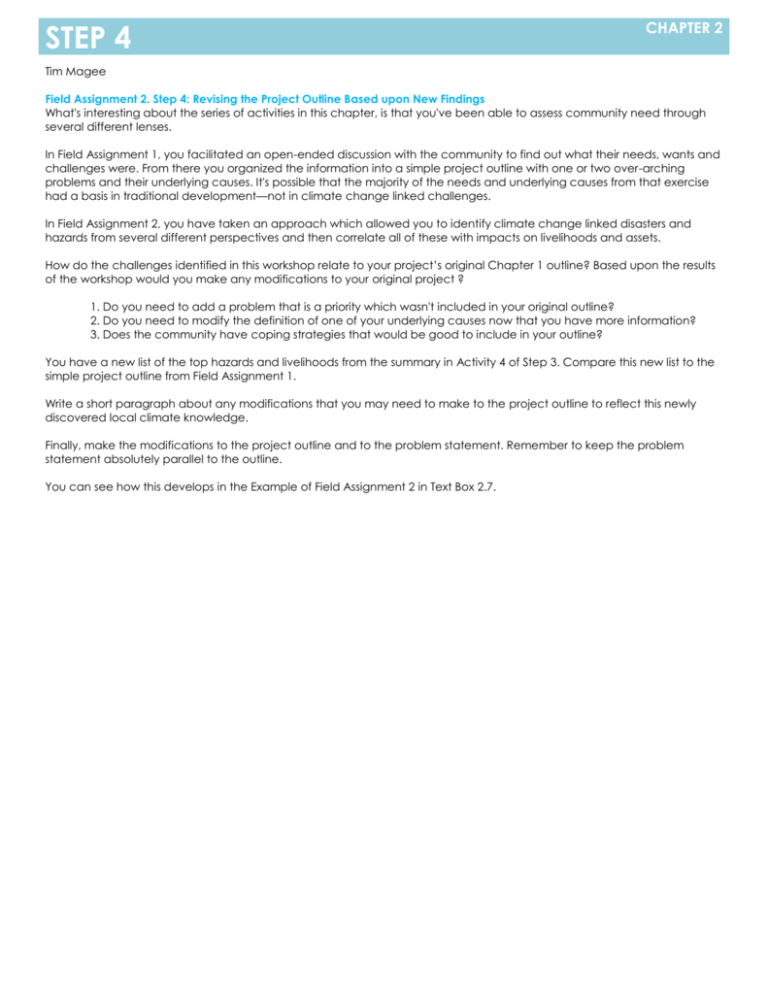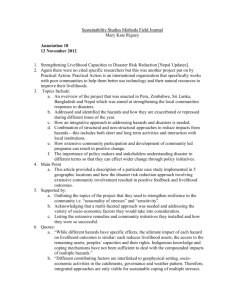
STEP 4
CHAPTER 2
Tim Magee
Field Assignment 2. Step 4: Revising the Project Outline Based upon New Findings
What's interesting about the series of activities in this chapter, is that you've been able to assess community need through
several different lenses.
In Field Assignment 1, you facilitated an open-ended discussion with the community to find out what their needs, wants and
challenges were. From there you organized the information into a simple project outline with one or two over-arching
problems and their underlying causes. It's possible that the majority of the needs and underlying causes from that exercise
had a basis in traditional development—not in climate change linked challenges.
In Field Assignment 2, you have taken an approach which allowed you to identify climate change linked disasters and
hazards from several different perspectives and then correlate all of these with impacts on livelihoods and assets.
How do the challenges identified in this workshop relate to your project’s original Chapter 1 outline? Based upon the results
of the workshop would you make any modifications to your original project ?
1. Do you need to add a problem that is a priority which wasn't included in your original outline?
2. Do you need to modify the definition of one of your underlying causes now that you have more information?
3. Does the community have coping strategies that would be good to include in your outline?
You have a new list of the top hazards and livelihoods from the summary in Activity 4 of Step 3. Compare this new list to the
simple project outline from Field Assignment 1.
Write a short paragraph about any modifications that you may need to make to the project outline to reflect this newly
discovered local climate knowledge.
Finally, make the modifications to the project outline and to the problem statement. Remember to keep the problem
statement absolutely parallel to the outline.
You can see how this develops in the Example of Field Assignment 2 in Text Box 2.7.
STEP 4
CHAPTER 2
Text Box 2.7
Course Project Example
Field Assignment 2. Step 4: Revising the Project Outline Based upon New Findings
Comparing and combining needs and challenges from Field Assignments 1 and 2
Outline from Field Assignment 1
Livelihood Assets and Hazards from Field Assignment 2
Problems:
Livelihood Assets and Resources Negatively Impacted by Hazards:
Chronic diarrhea in children
Food security and nutrition
Chronic under-nutrition
Income from agriculture
Crop productivity
Access to water
Causes:
Hazards:
Lack of knowledge of health, hygiene and nutrition
Unpredictable beginning and end to rainy season
Overall shortage of food and specifically for the
Intermittent drought during rainy season
four months preceding the corn harvest
Erratic rainfall during the rainy season
Increase in frequency of tropical storms and extreme weather
events (every two to three years); flooding
By comparing the two assessments side-by-side we can see that there are similarities with food security and nutrition. The vulnerability and
capacity assessment also added a new problem: insufficient agricultural income. This increases their vulnerability in times of stress and is
directly related to the newly identified underlying causes (hazards in the list above). Let’s add insufficient agricultural income to the
problem section of the project outline.
The community in the original needs assessment did not voice any climate change linked causes. In the vulnerability and capacity
assessment they raised the fact that a change in the timing of the growing season, drought, unpredictable rainfall during the rainy season,
and extreme tropical storms have reduced the productivity of their crops. These affect food security and nutrition, reduced agricultural
income, reduced access to water, and reduced production from their current cropping systems. Let’s add these climate change linked
challenges to the underlying causes section of the project outline.
The climate hazards identified by the community are clues to ideas that we can use in developing activities for the project in Chapter 4. For
example a change in the timing of the growing season could lead us to consider an activity that would explore drought resistant or early
maturing crops. Erratic rainfall during the rainy season could lead us to consider an activity that could include soil restoration by increasing
organic material to better hold water and by adding mulch to reduce evaporation. We could also consider water harvesting and water
conservation activities.
Revised Project outline (problems/causes/impacts) incorporating new information from the vulnerability and capacity assessment:
Problems:
Chronic diarrhea in children
Chronic under-nutrition
New problem identified in Field Assignment 2 activities
Insufficient income from agriculture
Causes:
Lack of knowledge of health, hygiene and family nutrition
Overall shortage of food and specifically for the four months preceding the corn harvest
New underlying cause related to climate change
Climate variability (unpredictable start and end of rainy season, erratic rainfall, and unusual dry periods), and extreme weather
events have reduced crop productivity and access to water
Revised Problem Statement:
300 small children from 100 families in four Guatemalan villages are frequently ill with chronic diarrhea caused by little knowledge of health
and hygiene, are chronically undernourished caused by little knowledge of nutrition and less than 12 months of food reserves. Their families
suffer from insufficient agricultural income due to climate variability that reduces crop production and access to water. These challenges
contribute to stunting and restrict the children's ability to attend and concentrate in school, leading to a reduction in their ability to develop
and prosper as adults. These challenges also reduce the ability of adults to lead the productive, meaningful, prosperous lives they need to
leave the cycle of poverty and contribute to the development of their communities.
In Conclusion
It's interesting to observe that the hazards, and the livelihood assets and resources were similar and consistent between the
four activities. On top of that, several of them are underlying causes to the problems which the community expressed. So,
for example, the climate challenges which have lead to reduced crop productivity and is an important underlying cause to
the challenges of insufficient income from agriculture, and for chronic under-nutrition.
RESOURCES
CHAPTER 2
CHAPTER 2 RESOURCES
Suggested Homework Assignment
The complete Field Assignment 2 homework to turn in will be:
1. A matrix showing:
a. A prioritized list of hazards identified by the community on the top row.
b. A prioritized list of livelihood assets and resources on the left column.
2. The results of a vote by the community on the matrix prioritizing which hazards make which livelihood assets and
resources the most vulnerable.
3. A short bullet point summary of the hazard and livelihoods results of each of the four activities.
4. A short list or description of coping strategies that the community members have come up with on their own.
5. A list of the community’s adaptive capacities in the format of the five capitals.
6. A simple comparison between your project outline from Field Assignment 1 and Activity 4, Step 3 summary of assets
and hazards.
7. A brief description of the changes you might make to your project outline.
8. A revised project outline including one or two new problems or underlying causes identified in Field Assignment 2.
Use the Example of Field Assignment 2 as the template for the assignment.
COURSE DOWNLOADS
Go directly to this book’s webpage, TimMagee.net/cba_field_guide, to download the following resources.
Field Assignment 2, Chapter 2
Example of Field Assignment 2
Participatory Capacity and Vulnerability Assessment Workshop Overview and How-to Card
Participatory Capacity and Vulnerability Assessment Workshop Lesson Plan
Seasonal calendar activity.
Hazard mapping activity.
Historical timeline activity.
Climate Hazard Impacts on Livelihoods.
GENERAL RESOURCES
These resources can be found by typing the title and organizational names into your Internet browser for the most current
link to the resource. Or, you can go to the CBA Field Guide webpage for links.
Theis, J and Grady, H. (1991) Participatory Rapid Appraisal for Community Development. International Institute for
Environment and Development. Online. Available HTTP: <http://pubs.iied.org/pdfs/8282IIED.pdf> (accessed 12 April 2012).
Livelihoods and Forestry Program (2010) Participatory Tools and Techniques for Assessing Climate Change Impacts and
Exploring Adaptation Options. Online. Available HTTP: <http://www.lfp.org.np/publications.php?id=34> (accessed 12 April
2012).
CARE International. (2009) Climate Vulnerability and Capacity Analysis Handbook. Online. Available HTTP:
<http://www.careclimatechange.org/files/adaptation/CARE_CVCAHandbook.pdf> (accessed 12 April 2012).
Copyright © 2012, Tim Magee. All rights reserved.










